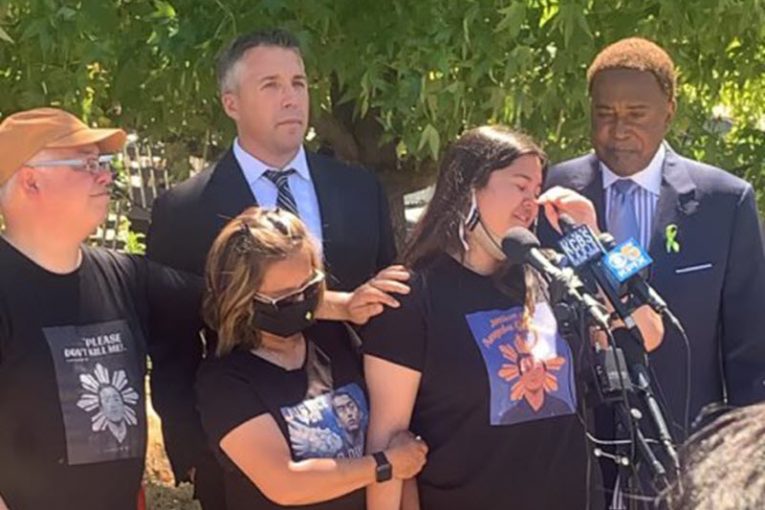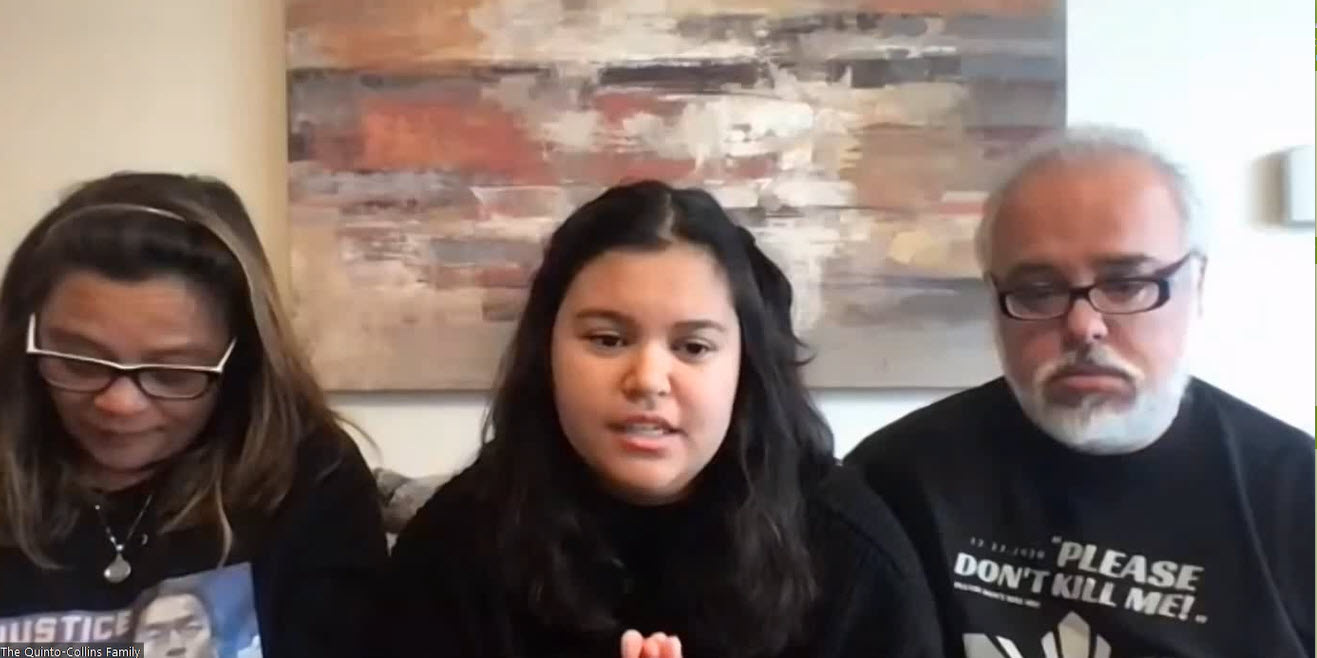

By David M. Greenwald
Executive Editor
Oakland, CA – The family of Angelo Quinto, along with Civil Rights Attorney John Burris, held a press conference on Wednesday in Oakland in response to a report from the Conta Costa DA’s Office that concluded “there is no evidence of criminal offense by Antioch Police officers in the death of 30-year-old Angelo Voithugo Quinto.”
Both Burris and his associate Ben Nisenbaum strongly disputed the DA’s report.
Nisenbaum said, “The District Attorney’s report contains serious inaccuracies about what happened during the incident, the actual cause of Mr. Quinto’s death, and ignores relevant law in deciding not to charge the officers.”
He added, “The District Attorney’s report also misrepresents the facts of what happened and omits the deposition testimony of the pathologist who initially claimed at the  Coroner’s Inquest that only excited delirium killed Mr. Quinto. In our deposition, that pathologist testified that Mr. Quinto’s breathing was compromised by weight on his back during the restraint, which was a factor in his death.”
Coroner’s Inquest that only excited delirium killed Mr. Quinto. In our deposition, that pathologist testified that Mr. Quinto’s breathing was compromised by weight on his back during the restraint, which was a factor in his death.”
According to Nisenbaum, “The pathologist also admitted that pictures from the second autopsy of Mr. Quinto showed numerous petechial hemorrhages in his eyes.”
Nisenbaum continued, “The County Coroner’s office still refuses to provide its autopsy pictures of Mr. Quinto that would show whether or not there was petechia in Mr. Quinto’s eyes, which are evidence of asphyxiation.”
John Burris said, “The District Attorney’s report takes the Defendant Officers’ accounts of what happened at face value, and does not address discrepancies in the evidence that disprove their accounts. The District Attorney’s report also failed to address how it could be reasonable to conduct a prone restraint lasting at least 5 minutes of a person who was handcuffed with his hands behind his back and not resisting during the rest of that restraint.”
According to the DA’s report, the incident was initiated on December 23, 2020, with a 911 call.
The DA noted, “Quinto’s sister wanted law enforcement’s help after Quinto was being erratic, physically aggressive, and harming his mother.”
When Antioch Police officers arrived, they were met by Quinto’s sister. When the officers arrived in the bedroom “they saw Quinto’s mother struggling with him in a bearhug hold on the ground. Officers separated the two. One officer kneeled and placed one knee on Quinto’s shoulder to handcuff him while the other held onto his legs.”
According to the DA’s account, “This was the extent of force utilized by the two officers to restrain Quinto, and to prevent him from harming himself, family members, or the officers.”
The DA cited the autopsy report which, as previously reported, determined the cause of death “was Excited Delirium Syndrome due to drug intoxication, psychiatric conditions, physical exertion, and cardiac arrest.”
A toxicology report by the Coroner’s Office showed that Angelo Quinto had the presence of caffeine, Levetiracetam (a therapeutic for adults and children with epilepsy), and Modafinil (a drug to stimulate wakefulness) in his system.
The Quinto family commissioned their own independent autopsy and its findings found the cause of death was restraint asphyxiation.
The private autopsy lists “petechial hemorrhaging as the basis for such conclusion. An independent toxicology report also found the presence of Fentanyl in Quinto’s blood – in addition to Modafinil and Levetiracetam.”
However, the DA disputes this, noting “of critical importance to the investigation, an internal examination showed no bone fractures or damage to Quinto’s larynx and trachea.”
While acknowledging that there are conflicting medical opinions as to the cause of death, the DA claims “the accounts of what transpired in the bedroom are consistent among all witnesses in that no police officer applied pressure to Quinto’s neck.”
Burris during the press conference disputed a lot of this account, noting that the initial drug screen at the hospital “indicated that he did not have any illegal drugs in his system, including fentanyl.”
Instead, he said, as his condition deteriorated, “They in fact gave him fentanyl then. That’s two or three days after he’s in the hospital.”
Burris said, “It’s hard to even fathom how the district attorney’s office can say that fentanyl was a contributing factor in his death, when in fact is it was given to him in a therapeutic clinical way and he did not (already) have it in his system.”
He added, “So the DA’s premises that he was under the influence of fentanyl at the time he had been brought, in at the time he had the confrontation with the police worker, (who) tackled him and taking down and doing the things that we all know that it was not in any way based upon his being under the influence of any drugs at all. And that is very, very disturbing.”
Burris noted the second autopsy which found he died of asphyxiation.
“That can only occur when you lose oxygen to your brain and your oxygen delivery system has been compromised,” he continued.
Burris noted that the initial pathologist upon deposition “conceded that it was an asphyxiation, and that in fact, it was caused by weight being placed upon his body, where his diaphragm in fact was suppressed.. Everybody knows that if you suppress a person’s diaphragm, they were cut off oxygen, but the need for your brain, you know, it causes brain death.”
Ben Nisenbaum noted about the DA’s report, that “it actually exonerated the police.” He said “it did that based on what appeared to be misrepresentations and in, and with respect to the fentanyl and outright lies.”
He said, “They had the medical records, so the DA’s investigators had to know that he was given fentanyl while as part of the course of medical treatment after the officers killed him at the scene, because that’s where he really died. That’s where Angelo died underneath the weight of these officers, pulseless in apnea, no heartbeat, not breathing when the paramedics came in and he had been that way. So he was dead then.”
The police claimed excited delirium.
Nisenbaum said, “I’ve deposed Dr. Rodian, I’ve taken his deposition twice now and we’ll take it a third time.”
He said they need to get the coroner’s photographs. Dr. Rodian, he explained, said that there were no petechial hemorrhages. Nisenbaum said, “We have photographs that show massive petechial hemorrhages in Quinto’s eyes. And they should have been there when Rodian did his autopsy.”
He explained that they describe Quinto as dying “prone, face down.” He explained, “This is what happens when you die from excited delirium, by the way, the officers restrain you prone, face down, they put weight on your back.”
This compromises your diaphragm. And in compromising your diaphragm, “it makes it impossible to expand your lungs, which makes it impossible to draw oxygen and breathe.”
He said, “So there’s another word for that one-word asphyxiation. That’s what killed Angelo.”
He said, this was mentioned at the inquest. “That’s the inquest where I laughed when I heard excited delirium, when I walked out, because it was a joke. It can’t be true. We knew it then. And it’s only been proven further each time that it’s, that it was asphyxiation.”
Burris and Nisenbaum have sent a letter to Attorney General Rob Bonta, which explicitly details the evidence against the involved officers and requests a review of the District Attorney’s charging decision for abuse of discretion.
The Quinto family contends that a charging decision based on lies, misrepresentations, and omissions is, by definition, an abuse of discretion and only underscores why the Attorney General’s intervention is necessary to achieve justice.
“The District Attorney’s charging decision seemed to take every step possible to avoid charging these officers. A fair investigation would rely on the facts of the case and the law, not bending the evidence to support the officers,” added Burris.
Nisenbaum said: “Once again, we have a situation where the District Attorney has refused to objectively apply the law to a set of clear facts that show the defendant police officers killed Mr. Quinto by asphyxiating him. The petechial hemorrhages throughout his eyes prove they compressed his body while restraining him. When questioned at deposition, the pathologist’s report of ‘excited delirium’ turned out to be asphyxiation by compression of the diaphragm during prone restraint.”






